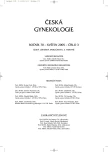-
Medical journals
- Career
Changes in Urethra Mobility after TVT Operation
Authors: J. Mašata 1; A. Martan 1; K. Švabík 1; P. Drahorádová 1; M. Pavlikova 2; J. Hlásenská 2
Authors‘ workplace: Gynekologicko-porodnická klinika VFN a 1. LF UK, Praha, přednosta prof. MUDr. A. Martan, DrSc. 1; Euromise centrum, Karlova univerzita a Akademie věd, Praha, ředitelka prof. RNDr. J. Zvárová, DrSc. 2
Published in: Ceska Gynekol 2005; 70(3): 220-225
Category: Original Article
Overview
Objective:
The aim of our study was to asses changes in the mobility of the whole urethra after successful TVT procedure.Design:
Prospective pilot study.Setting:
Obstet. Gynecol Department, General Teaching Hospital, Ist Medical Faculty, Charles University, Prague; EuroMISE Centre of the Charles University and Academy of Sciences, Prague, Czech Republic.Methods:
101 women with proven stressed urinary incontinence were included in the study. After the TVT procedure 90 women were evaluated. As a part of the complex urogynecological investigation before surgery the transperineal ultrasound scan was performed in supine position, urinary bladder was filled to 300 ml. In the orthogonal system of coordinates the position and mobility of the whole urethra before surgery were assessed. Control examination was done 3–6 months after the surgery. The changes induced by the surgery were assessed. For the statistical evaluation t-test, Wilcox test, F test, Kruskal-Wallis test and ANOVA were used.Results:
Surgery significantly decreased the mobility of the whole parts of the urethra during maximal Valsalva, but the position at rest is not influenced. The women with high urethral mobility have high mobility after the surgery. The operation was more effect in patients with high mobility. Never the less the change of relative mobility is the same in all women.Conclusions:
The information about the type of urethral mobility is important and may increase the success rate of TVT. Therefore the tension of the tape should be different for patients with different urethral mobility.Key words:
transperineal ultrasound, stress urinary incontinence, TVT
Labels
Paediatric gynaecology Gynaecology and obstetrics Reproduction medicine
Article was published inCzech Gynaecology

2005 Issue 3-
All articles in this issue
- Premature Separation of the Placenta – Etiology and Risk Factors
- Nalbuphine in Obstetrical Analgesia
- Changes of Coagulation Parameters during Stimulation in the IVF Programme and in Ovarian Hyperstimulation Syndrome
- Influence of Exogenous Supplementation with Luteinizing Hormone during Controlled Ovarian Hyperstimulation on the Results of IVF Cycle
- The Map of Superficial Lymphatic System of the Breast and Relation to the Sentinel Lymph Node
- On the Problem of Sentinel Lymphatic Nodes Examination in Mammary Cancer
- Histological Grade in Management of Carcinoma of Endometrium
- Reconstruction Procedures Following Pelvic Exenterations
- Metastasing and Relapsing „Low Grade“ Adenosquamous Metaplastic Breast Cancer – is There a Really Indolent Lesion? A Description of Three Cases and Review of Literature
- Immune, Inflammatory and Hormonal Changes in Connection with Laparoscopic Surgery
- Changes in Urethra Mobility after TVT Operation
- Laparoscopy in Chronic Pelvic Pain – a Prospective Clinical Study
- „Mixed“ and „Miscellaneous“ Vulvovaginitis: Diagnostics and Therapy of Vaginal Administration of Nystatin and Nifuratel
- Fistula as a Complication of Pelvic Actinomycosis – Two Case Reports
- Czech Gynaecology
- Journal archive
- Current issue
- Online only
- About the journal
Most read in this issue- Nalbuphine in Obstetrical Analgesia
- Premature Separation of the Placenta – Etiology and Risk Factors
- „Mixed“ and „Miscellaneous“ Vulvovaginitis: Diagnostics and Therapy of Vaginal Administration of Nystatin and Nifuratel
- Metastasing and Relapsing „Low Grade“ Adenosquamous Metaplastic Breast Cancer – is There a Really Indolent Lesion? A Description of Three Cases and Review of Literature
Login#ADS_BOTTOM_SCRIPTS#Forgotten passwordEnter the email address that you registered with. We will send you instructions on how to set a new password.
- Career

